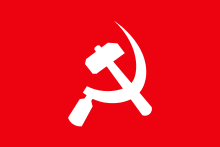Communist Party of Nepal
The Communist Party of Nepal (CPN; Nepali: नेपाल कम्युनिष्ट पार्टी) was a communist political party in Nepal from 1949 to 1962. Founded on September 15, 1949, it was formed to struggle against the autocratic Rana regime, feudalism and imperialism. The founding general secretary was Pushpa Lal Shrestha. Other members are Nar Bahadur Karmacharya, Niranjan Govinda Baidhya, and Narayan Bilas Joshi.
Communist Party of Nepal नेपाल कम्युनिष्ट पार्टी | |
|---|---|
| General Secretary | Tusli Lal Amatya |
| Founder | Pushpa Lal Shrestha |
| Founded | September 15, 1949 |
| Dissolved | 1962 |
| Succeeded by | Communist Party of Nepal (Amatya) Communist Party of Nepal (Rayamajhi) |
| Ideology | Communism Marxism-Leninism |
| Political position | Far-left |
History
CPN played an important role in the 1951 uprising that overthrew the Rana regime. After the Raksha Dal revolt in 1952, the CPN was banned on January 24, 1952.[1]
In 1954 the first party congress was held clandestinely in Patan. Manmohan Adhikari was elected general secretary.
In April 1956 the ban on the party was lifted.[1]
In 1957 the second party congress was held in Kathmandu. For the first time the party could hold its congress openly. Keshar Jung Rayamajhi was elected general secretary. The congress approved a republican party programme.
Rayamajhi supported the 1960 royal coup. This position prompted Ajoy Ghosh, leader of the Communist Party of India to advice Rayamjhi to rectify his positions and retain the struggle against the monarchy.[2] In early 1961 all political parties were banned. A wave of repression against CPN was initiated by the government. Rayamajhi, had however, expressed certain faith in the politics of the monarch, something that provoked stern reaction from other sectors of the party. To resolve the conflict a Central Plenum was convened in Darbhanga, India. The plenum lasted one month. Three lines emerged, a pro-constitutional monarchy line led by Rayamajhi, a line that wanted to restore the dissolved parliament and launch broad mass movements led by Pushpa Lal and a third line which favoured a constitutional assembly led by Mohan Bikram Singh. The latter line emerged victorious, but its sole representative in the Central Committee was Singh.
In April 1962 one section of the party convened a 3rd party congress in Varanasi, India. The congress approved the programme of National Democratic Revolution proposed by Tulsi Lal Amatya, and elected Tulsi Lal as general secretary. The congress decided to expel Rayamjhi. But the sector led by Rayamajhi, who controlled the Central Committee, did not recognize this congress as legitimate. Effectively the party had now been divided into two, one Communist Party led by Tulsi Lal Amatya and one Communist Party led by Keshar Jung Rayamjhi. These in turn faced further splits, mergers and renaming.
Electoral performance
| Election | Leader | Votes | Seats | Position | Resulting government | |
|---|---|---|---|---|---|---|
| # | % | # | ||||
| 1959 | Keshar Jung Rayamajhi | 129,142 | 7.2 | 4 / 109 |
4th | Congress |
Leadership
General Secretaries of Communist Party of Nepal (1949-1962)
- Pushpa Lal Shrestha, 1949-1954
- Man Mohan Adhikari, 1954-1957
- Keshar Jung Rayamajhi, 1957-1962
- Tulsi Lal Amatya, 1962
See also
- List of communist parties in Nepal
- Communist Party of Nepal (Maoist)
- History of Nepal
- Arbind Rimal
References
- SINHAS Abstracts: Volume 2, No. 2 Archived 2007-02-06 at the Wayback Machine
- Parajulee, Ramjee P.. The Democratic Transition in Nepal. Rowman & Littlefield, 2000. p. 72
